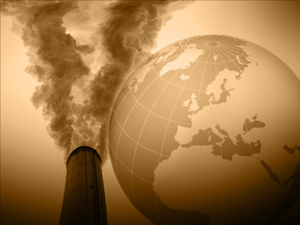World approaching ‘Carbon Cliff’, new report warns
By Stephen Leahy | Last updated: Nov 19, 2012 - 12:43:10 PMWhat's your opinion on this article?

|
“This isn’t about shock tactics, it’s simple math,” said Leo Johnson, partner of PricewaterhouseCoopers International Limited (PwC), one of the world’s largest accounting firms, which wrote the report.
“We’re heading into uncharted territory for the scale of transformation and technical innovations required” to reduce carbon emissions enough to prevent disaster, Mr. Johnson said.
With only three weeks until the United Nations climate change conference in Doha, the PwC Low Carbon Economy Index analysis, illustrates the scale of the challenges that negotiations in Doha are likely to face.
Since the 2009 Copenhagen climate summit, scientists and non-governmental organizations (NGOs) alike have called on countries to set higher emissions reduction targets and put policies in place to meet them. Those calls have gone largely unanswered, as the PwC report shows.
The report shows that while there was a .7 percent decrease in global carbon emissions per unit of GDP (a measure known as carbon intensity) in 2011, that amount is a fraction of what is required to meet the international commitment to limit a global rise in temperature to two degrees Celsius.
“We now have to reduce emissions by 5.1 percent per year, every year from now until 2050,” said Jonathan Grant, director of Sustainability and Climate Change at PwC.
“It looks very unlikely that we will be able to achieve those targets,” Mr. Grant said in video press conference.
If emission reductions had begun in 2000, the reduction rate would have been 3.7 percent. Even if the recent decline in emissions growth doubles to 1.5 percent per year, global temperatures will still soar above four degrees Celsius, the report concluded.
A four-degree increase means a world that is hotter than any time in the last 30 million years. Ground temperatures will be two degrees Celsius warmer in some places, eight to ten degrees hotter in Canada and parts of Europe, and 15 degrees warmer in the Arctic and other regions. Drought and high temperatures will decimate Africa and many tropical areas of the planet.
A world that is warmer by four degrees Celsius also means a one- to two-meter sea level rise by 2100 that would leave hundreds of millions homeless. Oceans will be too acidic for corals, shellfish and most plankton, and many species of fish will be adversely affected.
The scale of the challenging of reducing carbon emissions is such that the United States would have to convert all of its coal-fired power plants to natural gas in the next eight years to meet its Copenhagen pledge of a 17 percent reduction from 2005 levels. Yet even that pledge is inadequate compared to other industrialized countries.
The United Kingdom pledged to reduce emissions to 34 percent below 1990 levels and is currently 18 percent below 1990 levels. To meet its pledge, all coal-fired power stations in the UK would have to close by 2020, the PwC report suggested.
China, India, Russia and Brazil will also have to make annual reductions ranging from three to seven percent in their carbon intensity in order to meet their pledges.
Even fulfilling those pledges, however, puts the planet on a path to a temperature increase of three-and-a-half degrees Celsius, according to the Climate Action Tracker (CAT). CAT is an independent science-based assessment that tracks the emission commitments and actions of countries.
Limiting global warming to two degrees Celsius is not impossible, despite so many warnings, said Marion Vieweg, a policy analyst at CAT.
Ms. Vieweg is critical of the PwC report for simply using past carbon emission reductions as a guideline for what’s possible. “It is only with a coherent strategy of alternative energy sources, technologies, activities, net costs, benefits, etc. can one judge how feasible deep reductions are,” Ms. Vieweg told IPS. Such integrated studies have been done and they show the “required deep cuts are feasible and affordable,” she said.
Achieving these cuts, however, is gradually becoming more difficult as serious action continues to be delayed. It has never been a secret that the required reductions are unprecedented historically, she said. “What is important is to understand how to achieve them. And then do it.”
INSIDE STORIES AND REVIEWS
-
-
About Harriett ... and the Negro Hollywood Road Show
By Rabiah Muhammad, Guest Columnist » Full Story -
Skepticism greets Jay-Z, NFL talk of inspiring change
By Bryan 18X Crawford and Richard B. Muhammad The Final Call Newspaper @TheFinalCall » Full Story -
The painful problem of Black girls and suicide
By Charlene Muhammad -National Correspondent- » Full Story -
Exploitation of Innocence - Report: Perceptions, policies hurting Black girls
By Charlene Muhammad -National Correspondent- » Full Story -
Big Ballin: Big ideas fuel a father’s Big Baller Brand and brash business sense
By Bryan Crawford -Contributing Writer- » Full Story






 Click Here Stay Connected!
Click Here Stay Connected!








